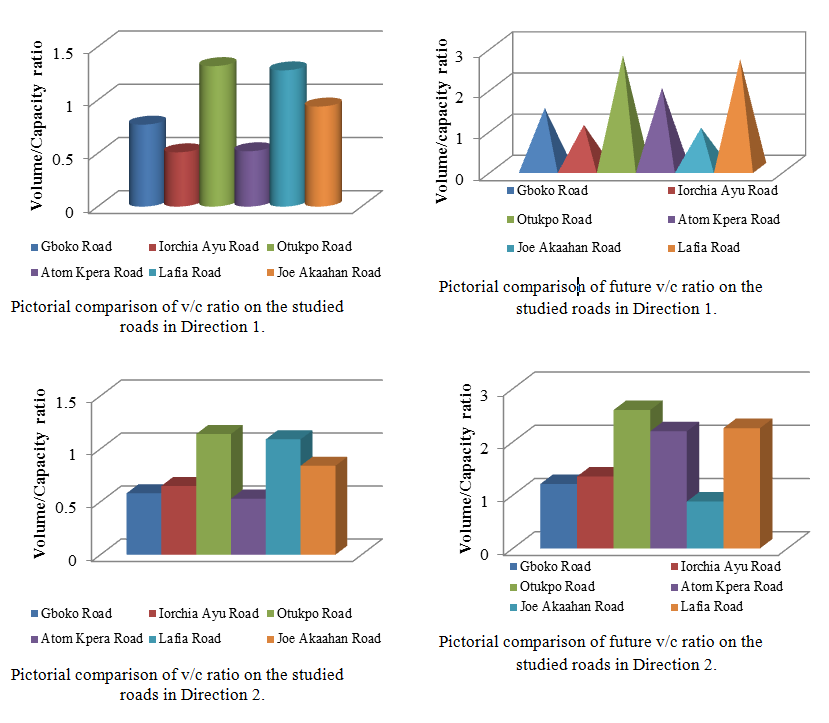Empirical Assessment of Mixed Traffic Congestion on Selected Arterials in an Urban Metropolis, Nigeria
DOI:
https://doi.org/10.57056/ajet.v7i1.2Keywords:
Traffic congestion, Urban roads, Developing city, Traffic management, Mixed trafficAbstract
The study was aimed at investigating the appropriateness and development of congestion indices and predictive model with operational parameters for congestion on the roads of a developing city. A manual 12-hour (6.00 am- 6.00 pm) traffic count was conducted for seven consecutive days of the week and converted to passenger car units (pcu) on Gboko, Iorchia Ayu, Otukpo, Joe Akaahan, Atom Kpera and Lafia roads of Markurdi to determine congestion spots. Five parameters of volume, headway, speed, density and delay were derived from the generated database in accordance with Highway Capacity Manual of 2010. Traffic congestion indices, with corresponding predictive models, were quantified, and a 15-year congestion forecast made to obtain the future operating scenarios on Makurdi roads. Makurdi roads were dominated by cars of 38.09-61.87%, motorcycles of 15.58-22.85%, minibuses of 10.63-31.33%, and tricycles, luxurious buses, lorries/trucks, trailers/tankers of 0.03-7.75%; with operating significant parameters at peak period of 2322-3134 pcu/h., 305-990 pcu/km., 1.7-2.2 s and 17-40 km/h for the volume, density, headway and speed, respectively; the degree of congestion on the selected routes were moderate to severe (volume capacity ratio of 0.51-1.32) and substantially dependent on the operating parameters, predictive model for the roadway traffic congestion index, CI = 107.071+0.028v+10.054Sl +0.013c with R2 = 0.97, was generated with volume (v), segment length (Sl) and capacity (c); and a 15-year projection indicated that Joe Akaahan Road would be heavily congested. All other segments would be severely congested. The present and 15-year projected CI values were 1.83 and 3.77 respectively, indicating extra vehicle kilometer travel due to congestion of 377%. It is recommended that congestion indices and predictive model are useful tools for management of congestion on urban roads of a developing city.
References
US Department of Transportation. ITS National Intelligent Transportation, Systems Program Plan Five – Year Horizon, 2002.
Melissa H, Scott D, Amarjit S, Thin S. A Comparison of Traffic Performance in Highly Congested Urban Areas, International Journal of Traffic and Transportation Engineering. 2016; 5(3):47- 63.
HighwayCapacity Manual (HCM), 5th Edition, Volume 3: Uninterrupted Flow, 2010; Transportation Research Board, National Research Council, Washington, D.C.
Pima Association of Governments, PAG, Volume/Capacity Ratios, 2005; Tucson, Arizona.
Federal Highway Administration, FHWA. Freight Management and Operations, Chapter 5: Capacity and Performance Analysis, United States Department of Transportation (USDOT) 2014.
Design Manual for Roads and Bridges, DMRB. Traffic Capacity of Urban Roads, Part 3TA 79/99, 1999; Amendment No 1, Vol.5, Section 1.

Downloads
Published
How to Cite
Issue
Section
License
Copyright (c) 2023 Terseer Ako, Ibrahim Tunde Yusuf, Fwanshak Gaius Mije

This work is licensed under a Creative Commons Attribution-NonCommercial 4.0 International License.





